One year on since the onset of the coronavirus pandemic, we’re taking stock of COVID-19’s impact on learning. With the help of our users, we’re able to pull out some trends on the impact of the coronavirus on our desire to learn, our motivation to learn, and our learning priorities. We will also assess COVID-19’s impact on workplace learning as well as the role of training providers in helping learners get the training they need.
The below 2020 results are taken between March 1st and March 31st while the 2021 results are taken between January 1st and March 7th.
Headline Statistics: The impact of COVID-19 on learning - 1 year on
I. Impact on Individual Learners
- More people than ever want to learn. More than half of respondents (55%) are more likely to learn in the next 3 months due to COVID-19.
- Top reasons for respondents to learn something new include: having the time to study, focus on employability, and reskilling to switch careers.
- Vocational courses have risen significantly in popularity (31% in 2021 vs 18% in 2020). One of the largest searches in the wake of the pandemic has been for qualifications that lead to an obvious career path or are highly specialised.
II. Impact on Workplace Learning
- L&D professionals reported a positive outlook for training activity one year on: less postponement of training, no cancellations of training, and less stopping of the use of external trainers.
III. The Role of Training Providers
- Training providers and colleges can help learners access the training they need by offering virtual options of training courses as well as more flexibility in terms of rebooking and cancellation policies.
View the infographic
COVID-19: Impact on Individual Learners
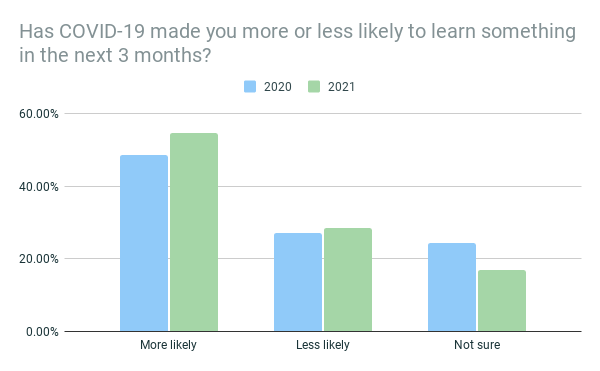
The trend for learning remains strong one year on. In 2021, more than half of the respondents (55%) are more likely to learn in the next 3 months due to COVID-19, whereas 17% are unsure.
Of the 55% who are more likely to learn, 52% already preferred online learning as a learning environment.
For those who are unsure, 44% want training providers to do more to highlight online options and 17% want free rebooking options to help them feel more comfortable about booking a training course.
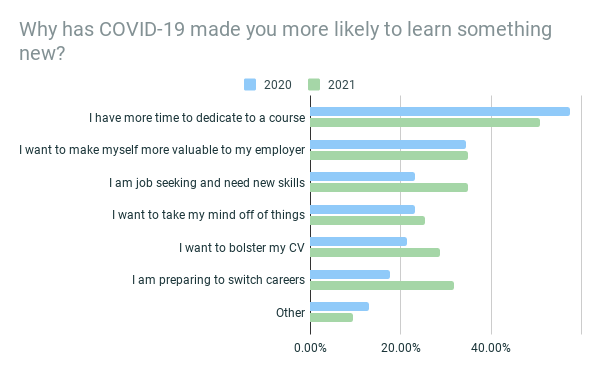
The top reasons for those who say they expect to learn more because of COVID-19 have remained consistent compared to a year ago. In 2021, 51% say this is because they’ll have more time to dedicate to a course. This is lower than the 58% of users who chose this reason a year ago.
Other key reasons focus on employability and job-seeking ability: 35% want to become more valuable to their current employers, 35% need new skills to help with their job-seeking efforts and 29% want to bolster their CVs.
Interestingly, those who want to learn in preparation to switch careers have jumped up to 32% (vs. 18% in 2020). Similarly, those looking to learn because they are job hunting increased substantially to 35% in 2021 from 23% in 2020. This affirms our recent findings that there is a strong appetite among learners to both reskill and upskill in 2021.
Given users’ focus on training for employability and career reasons, it would be helpful for colleges and training providers to highlight how their training courses could help learners progress in their careers or reskill to change careers.

Stress is by far the main factor that people cite as the reason they are less likely to learn something new in the coming months. The percentage of respondents who say they are too stressed to think about learning has almost doubled to 59% in 2021 from 30% in 2020.
Some users state that they are worried about the coronavirus health risks from being in a physical classroom, and that they couldn’t find well-supported online courses. This might be an opportunity for some training providers to focus on providing more personalised support to help these learners study online.
Nevertheless, there are indications that stress caused by the pandemic will reduce in the near future. The ONS cites in a March 2021 report that although personal well-being levels are still below February 2020 (pre-lockdown) levels, there has been a gradual improvement in well-being measures. This is likely due to the progress of the ongoing vaccination programme as well as the government’s announcement of a roadmap to ease lockdown restrictions.
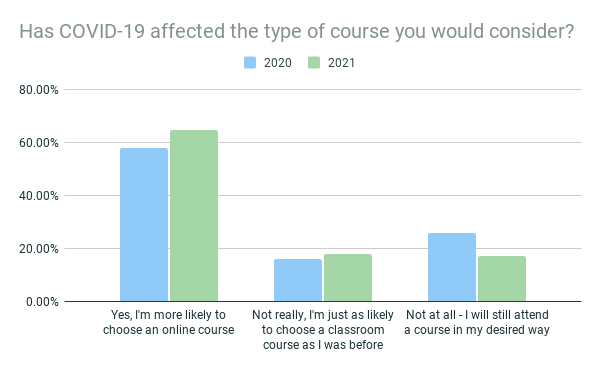
Users’ preference for online learning has increased one year on with an increased proportion indicating that they are more likely to choose an online course (65% in 2021 vs 58% in 2020).
Users have generally embraced the necessary changes in the learning environment and shown a remarkable adaptability in moving out of their comfort zone. Respondents who insist on only attending a course in their desired way have reduced to 17% in 2021 from 26% in 2020.

Similar to in 2020, the most popular type of course among users in 2021 is a professional course. However, the percentage of users who have considered studying a professional course has fallen to 55% from 68% in 2020.
In contrast, vocational courses have risen in popularity, with an increased proportion considering taking a vocational course e.g. a Level 2 or Level 3 course (31% in 2021 vs 18% in 2020).
This supports our recent findings that in the wake of the pandemic, one of the largest searches has been for qualifications that lead to an obvious career path or are highly specialised for e.g. BTEC qualifications - download our full trend report on qualification searches.

In 2021, just like we noted in our preliminary 2020 report of COVID-19’s impact on learning, respondents are focused on training to get qualifications and skills in the coming months.
Learners are also showing strong interest in management, engineering and counselling training courses.
Training providers who can clearly highlight how their training courses could help learners get the skills and qualifications they need are more likely to enroll the students on their courses.
COVID-19: Impact on Workplace Learning
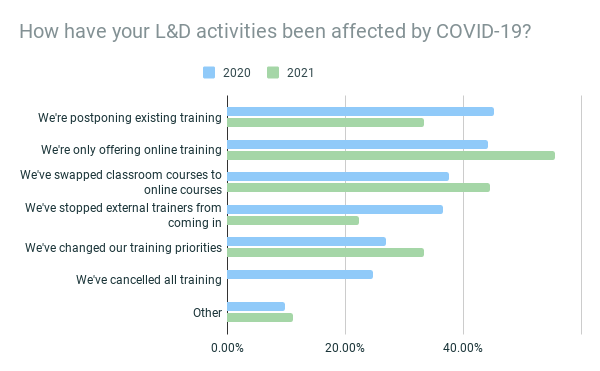
L&D professionals reported a positive outlook for training activity one year on from March 2020. There is less postponement of training (33% vs. 45% in 2020), no cancelled training (0% compared to 25% in 2020) and less stopping of the use of external trainers (22% vs. 37% in 2020).
The uptake of online courses appears to have driven the increased training activity. Companies that are only offering online training increased to 56% in 2021 (vs. 44% in 2020). Likewise, organisations that have swapped classroom courses to online courses increased to 44% (from 38% in 2020).
Colleges and training providers should therefore focus on offering online options of their training courses as well as look into what would make learners more comfortable about booking a training course (see next section).
COVID-19: The Role of Training Providers
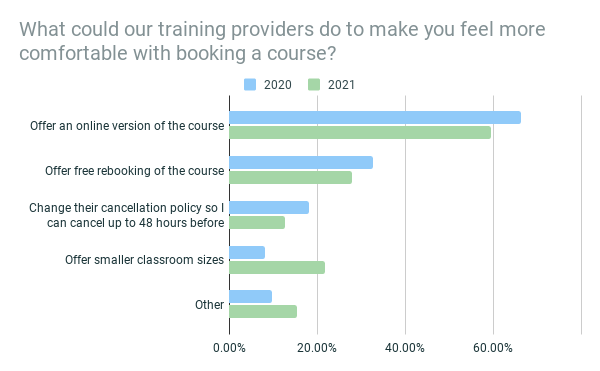
Similar to a year ago, a significant majority of users in 2021 (59%) would like training providers to offer virtual versions of their training programs.
Training providers and colleges can therefore help learners access the training they need by offering virtual options of training courses as well as more flexibility in terms of rebooking and cancellation policies.
Download our report: The 3 Challenges Facing UK Workers
.jpg?width=1200&name=3%20challenges%20facing%20uk%20learners%20(1).jpg)
The Impact of COVID-19 on Learning: One Year On - Infographic
You may use this infographic for your own content if you wish, but please ensure you cite www.findcourses.co.uk
.png?width=800&name=covid-19%20infographic%20(1).png)


.png)

.jpg)
-Oct-29-2025-11-53-41-3462-AM.jpg)

